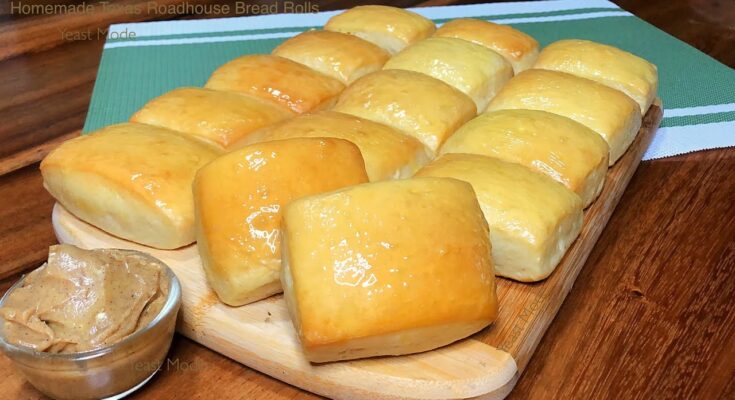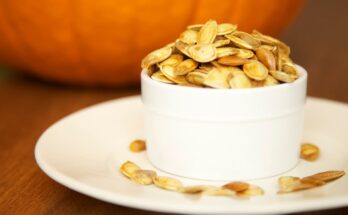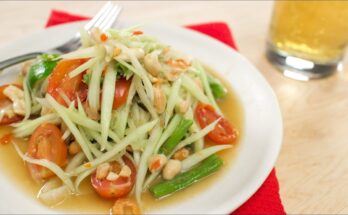Texas Roadhouse Roll Recipe: There’s something magical about sinking your teeth into a warm, buttery Texas Roadhouse roll. If you’ve ever visited the restaurant, you know these soft, golden-brown pillows of joy aren’t just bread—they’re an experience. What if we told you that you could recreate that experience right in your own kitchen? Yep, no reservations required.
This comprehensive guide will walk you through every single step to recreate those irresistible Texas Roadhouse rolls at home. From the ingredients you’ll need, to kneading techniques, rise times, and baking tips—plus that heavenly cinnamon honey butter—we’re leaving no crumb unturned.
Why These Rolls Are So Popular
Walk into a Texas Roadhouse, and you’re likely to be greeted not by a host but by the smell of freshly baked bread. Those rolls are often the highlight of the meal—soft, fluffy, warm, and served with that creamy honey cinnamon butter. They’re comfort food at its finest.
It’s not just the taste, though. It’s the texture—light as air, with a slightly chewy pull that satisfies with every bite. And let’s not forget their subtle sweetness, which makes them the perfect companion for a savory steak dinner or as a snack all on their own.
What Makes Them Unique?
Unlike typical dinner rolls, Texas Roadhouse rolls are:
- Slightly sweet, with a delicate hint of honey
- Light and fluffy, thanks to a perfect proofing process
- Buttery and golden, from an egg wash and post-bake butter glaze
They also have just the right balance of chewiness and softness. The key lies in a few unique ingredients (like honey) and the attention to detail in each step of preparation.
Ingredients You’ll Need for Texas Roadhouse Rolls
Basic Pantry Ingredients
Let’s keep it simple. You don’t need any hard-to-pronounce ingredients to make these rolls. Most of them are probably already sitting in your pantry or fridge. Here’s what you’ll need:
- All-purpose flour – The base of your dough
- Active dry yeast – The rising agent that gives the rolls their lift
- Milk – For moisture and richness
- Butter (unsalted) – For flavor, richness, and that glossy finish
- Sugar – Adds sweetness and helps activate the yeast
- Eggs – Provide structure and help bind the dough
- Salt – Essential for balancing flavors
- Honey – The secret to that subtle sweetness
Secret Ingredients That Make a Difference
Sure, flour, eggs, and yeast are staples—but honey and milk take these rolls to another level. The honey gives the dough a gentle sweetness without overpowering it, while the milk enriches the dough and keeps it tender.
Want to kick it up a notch? Use bread flour for a slightly chewier texture, or add a tablespoon of dry milk powder to boost softness.
Ingredient Substitutions and Tips
Can’t do dairy? No problem.
- Swap out milk with almond or oat milk.
- Replace butter with vegan margarine.
- Use a flax egg (1 tbsp flaxseed + 2.5 tbsp water) if you’re going egg-free.
Just note that while these swaps can get close to the original, the texture might vary slightly.
Tools and Equipment You’ll Need
Must-Have Kitchen Tools
Great rolls start with the right tools. While you don’t need a professional kitchen setup, a few tools will make your baking experience smoother.
- Mixing bowls – Preferably a large one for rising
- Measuring cups and spoons – Accuracy is key
- Stand mixer with a dough hook (optional but highly recommended)
- Rolling pin – For flattening dough evenly
- Baking sheet – Heavy-duty and nonstick is ideal
- Plastic wrap or clean kitchen towel – For covering dough while it rises
- Pastry brush – To butter your rolls after baking
Optional Tools for Easier Baking
- Dough scraper – Helps in kneading and cutting dough
- Instant-read thermometer – To check dough temperature and water temp for yeast
- Bench mat or silicone mat – Makes cleanup a breeze
You don’t need all these, but the more you have, the easier the process becomes.
Prepping Before You Start
Setting Up Your Workspace
Clean your counters, gather your ingredients, and set out all your tools. Baking is part art, part science—and organization goes a long way in ensuring your dough rises perfectly and your rolls come out fluffy and golden.
Place ingredients in order of use. Warm up your milk and melt your butter slightly. Have a timer or phone handy to track rise times.
Measuring Your Ingredients Accurately
Don’t eyeball it. For baking, precision matters more than in any other type of cooking. Use a kitchen scale if you have one. Especially when measuring flour—too much can make your rolls dense.
Tip: Always spoon your flour into the measuring cup and level it off with a knife. Don’t scoop directly from the bag.
Yeast Activation Tips
Yeast is a living thing, and it needs the right environment to do its job.
- Warm your milk to about 100°F to 110°F (not hot, or you’ll kill the yeast).
- Add sugar to help feed the yeast.
- Wait for 5-10 minutes after adding yeast to warm liquid. It should bubble and foam. That’s how you know it’s alive and ready to go.
Step-by-Step Guide to Making Texas Roadhouse Rolls
Step 1: Mixing the Dough
In a large mixing bowl, combine 1 cup warm milk (about 110°F), ¼ cup melted butter, ¼ cup sugar, 1 egg, and 2¼ teaspoons (1 packet) active dry yeast. Whisk gently and let the mixture sit for 5 minutes until the yeast starts to foam. Gradually stir in 3½–4 cups of all-purpose flour and 1 teaspoon of salt. Mix until a soft dough begins to form—it should be slightly sticky but manageable.
Step 2: Kneading the Dough
Transfer the dough to a floured surface and knead for about 7–10 minutes, adding small amounts of flour as needed until the dough becomes smooth, elastic, and springy to the touch.
Step 3: Letting the Dough Rise
Place the dough in a greased bowl, cover it with plastic wrap or a damp towel, and let it rise in a warm spot for 1–1½ hours, or until doubled in size.
Step 4: Shaping the Rolls
Punch down the risen dough, roll it out to about ½ inch thick, and cut into 2-inch squares or circles.
Step 5: Second Rise
Arrange the dough pieces on a greased baking tray, leaving space between them. Cover and let rise again for 30–40 minutes, until puffy.
Step 6: Baking to Perfection
Preheat your oven to 350°F (175°C). Brush the rolls with melted butter and bake for 12–15 minutes, until golden brown. Brush again with butter after baking for that signature Texas Roadhouse shine and softness.
Making the Iconic Honey Cinnamon Butter
Ingredients for the Butter
Texas Roadhouse rolls wouldn’t be complete without their dreamy sidekick—honey cinnamon butter. It’s creamy, sweet, and has just the right amount of spice. Here’s what you need:
- ½ cup unsalted butter, softened
- ¼ cup powdered sugar
- ¼ cup honey
- 1 teaspoon ground cinnamon
Make sure your butter is room temperature for smooth blending. Cold butter won’t mix properly and may leave lumps.
Blending the Flavors Together
In a medium bowl, beat all the ingredients together until smooth and fluffy. Use a hand mixer or whisk vigorously by hand.
Transfer the butter to a small serving dish and refrigerate for 20–30 minutes if you want a firmer consistency. Otherwise, serve it soft and melty alongside your fresh-baked rolls.
Pro Tip: Make extra—it stores well in the fridge for up to 2 weeks and goes great on pancakes, waffles, muffins, or even toast!
Tips and Tricks for Perfect Rolls Every Time
Common Mistakes and How to Avoid Them
Even seasoned bakers can run into trouble if they’re not careful with bread dough. These common missteps can ruin an otherwise flawless batch of rolls. Here’s how to steer clear of them:
- Using water that’s too hot for the yeast – This is a recipe killer. Hot water can kill the yeast instantly. Always aim for water/milk between 100°F–110°F.
- Skipping the second rise – It may seem optional, but it’s absolutely not. This second proof is what gives the rolls their lift and lightness.
- Adding too much flour – It’s tempting to keep adding flour when the dough feels sticky, but this will make your rolls dense and dry. The dough should be tacky—not dry.
- Underbaking – Pulling them out too soon results in doughy centers. Make sure the tops are golden brown, and they sound slightly hollow when tapped.
- Not greasing your bowl or pan properly – Dough can stick badly if you skip this step, and that can ruin the shape of your rolls.
Pro Tips for Soft, Fluffy Rolls
Want to bake like a Texas Roadhouse chef? Keep these pro tips in your apron pocket:
- Let your dough proof in a warm, humid area – A slightly warm oven (turned off) with a bowl of hot water placed inside can help create an ideal environment.
- Use bread flour instead of all-purpose flour – For even more structure and softness.
- Brush your rolls with butter twice – Once right after baking, and again a few minutes later. The butter seeps in and adds an incredible richness.
- Don’t rush the process – Good bread takes time. Each step—especially rising—is essential to get that soft, pillowy texture.
- Make ahead – Let the dough rise overnight in the fridge. This slow rise develops better flavor and makes morning baking much easier.
How to Store and Reheat Leftover Rolls
Freezing and Thawing Instructions
Can’t finish the whole batch in one go? No worries—Texas Roadhouse rolls freeze beautifully. Follow these steps to save some for later:
- To freeze unbaked rolls: After shaping the dough, place the rolls on a baking sheet lined with parchment paper. Freeze until solid, then transfer them to a zip-top freezer bag. When ready to bake, let them thaw and rise for several hours before popping them in the oven.
- To freeze baked rolls: Let the rolls cool completely. Wrap them in aluminum foil or store in airtight containers or freezer bags. They’ll keep well for up to 2 months.
Best Reheating Methods
No one wants a soggy or hard roll. Here’s how to reheat them so they taste fresh out of the oven:
- Microwave (Quick Option): Wrap the roll in a damp paper towel and heat for 15–20 seconds. The steam keeps it soft.
- Oven (Best Option): Preheat to 300°F, wrap rolls in foil, and warm for 10–15 minutes. Brush with butter afterward for that just-baked feel.
- Air Fryer: Pop them in at 300°F for 3–5 minutes. Quick and crispy edges!
Avoid reheating too many times, as it can dry them out. Store them in portions to make things easier.
Serving Suggestions
Best Meals to Pair With Texas Roadhouse Rolls
Texas Roadhouse rolls are incredibly versatile. They go well with almost anything, but here are a few pairings that elevate them even more:
- Steak Dinners – Naturally, these rolls shine next to a juicy ribeye or sirloin.
- Southern Comfort Food – Serve with fried chicken, mashed potatoes, and gravy.
- BBQ Plates – Pulled pork or brisket with a buttery roll? Absolute heaven.
- Holiday Meals – They’re a fantastic addition to Thanksgiving or Christmas dinners.
Want to keep it simple? Just load a warm roll with honey butter and enjoy it as a snack or breakfast treat.
Making It a Crowd-Pleasing Appetizer
Hosting a party? Serve your rolls warm with a trio of butters: honey cinnamon, garlic herb, and whipped maple. It’s a show-stopping appetizer that’s guaranteed to get rave reviews.
You can even turn these rolls into mini sandwiches. Slice them open and fill with:
- Shredded BBQ chicken
- Turkey and cranberry
- Ham and Swiss with mustard
Small, soft, and just sweet enough—they’re a perfect base for sliders or finger food bites.
Nutritional Information
Caloric Breakdown
Let’s be real—these rolls aren’t exactly “light,” but they’re worth every calorie. Here’s an approximate breakdown for one roll (without butter):
| Nutrient | Amount per Roll (Approx.) |
|---|---|
| Calories | 180–220 kcal |
| Carbohydrates | 28–32g |
| Protein | 4–5g |
| Fat | 6–8g |
| Sugars | 5–8g |
| Fiber | 1g |
| Sodium | 200–250mg |
Add a tablespoon of cinnamon honey butter and you’re looking at about 90 more calories—but let’s face it, it’s the best part.
Healthier Ingredient Alternatives
Watching your macros? You can still enjoy a version of these rolls with a few tweaks:
- Swap all-purpose flour with whole wheat flour (start with 50/50 ratio)
- Use Greek yogurt instead of eggs or oil
- Reduce sugar and use stevia or monk fruit sweetener
- Replace butter with olive oil or vegan margarine
While the taste and texture will differ slightly, you can still capture the essence of those delicious rolls with a little creativity.
FAQs about Texas Roadhouse Roll Recipe
1. What’s the best flour for soft rolls?
Bread flour gives you chewier rolls, but all-purpose flour works just fine and produces a softer crumb. For an ultra-light texture, you can also sift your flour before mixing.
2. Can I make the dough the night before?
Yes! Make the dough, let it rise once, punch it down, and refrigerate overnight. Shape and let rise again the next day before baking.
3. Do these taste exactly like the restaurant version?
They’re incredibly close—soft, sweet, and buttery. Some might even say better, especially when they’re warm out of the oven.
4. How do I get a golden crust?
An egg wash before baking helps, but brushing melted butter both before and after baking creates a beautiful golden finish and enhances flavor.
5. Can I use a bread machine?
Yes! Add ingredients in the order recommended by your machine (usually wet first, then dry, yeast last), use the dough setting, then shape and bake as instructed.
Conclusion
There you have it—everything you need to make your very own Texas Roadhouse rolls at home. From prepping your ingredients to that final brush of warm, melted butter, you’re now equipped with all the know-how to recreate one of the most beloved restaurant bread rolls ever made.
And honestly? They might even taste better when you make them yourself.
Don’t be surprised if your family asks for these at every holiday, Sunday dinner, or even as a weekday treat. These rolls are soft, fluffy, golden, and rich with just the right touch of sweetness. Pair them with a bowl of chili, a steak dinner, or serve them fresh with honey cinnamon butter for a snack you’ll crave again and again.
So, roll up your sleeves, turn on some music, and enjoy the simple pleasure of baking something that brings a whole lot of joy to your table.



